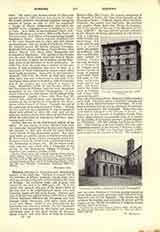

Cortona, Diocese of (CORTONENSIS), immediately subject to the Holy See. Cortona is a small city in the province of Arezzo, Tuscany, Central Italy, situated on a commanding hill, and overlooking the Lake of Perugia. Its cyclopean walls, still in great part preserved, are said to be 3000 years old. It is certainly very ancient, was one of the twelve cities of CATHEDRAL, CORTONA (Designed by Antonio da Sangallo?) Etruria, and in its neighborhood many ruins and Etruscan tombs are still to be found. Cortona took and the other churches of Cortona possess numerous part in all the wars against Rome, until 310 B.C., when works of art, especially paintings of the school of Luca Fabius Rullianus defeated the Etruscans and took Signorelli and of Fra Angelico. The diocese has 50 Perugia which, thereupon, with other cities, made parishes, 60 churches and oratories, 85 secular and 36 peace with Rome. Later it was destroyed by the regular priests, 30,200 inhabitants, 6 religious houses Lombards but was soon rebuilt. In the fourteenth century it was governed by the Casali, and became afterwards part of the great Duchy of Tuscany. Many famous men were born or lived in Cortona: Brother Elias (Elia Coppi), the famous companion of St. Francis of Assisi, and later Vicar-General of the Franciscan Oder; Cardinals Egidio Boni and Silvio Passerini; the painter Luca Signorelli; the architect and painter Peitro Berrettini (Peitro da Cortona). One of the glories of the city is St. Margaret of Cortona (1248-97). She was born at Laviano (Alviano) in the Diocese of Chiusi, and formed an evil relation with a nobleman of the vicinity. On discovering his body after he had met a violent death, she repented suddenly, and after a public penance, retired to Cortona, where she took the habit of a Tertiary of St. Francis and devoted her life to works of due to her zeal. Leo X permitted her veneration at Cortona, and Urban VIII extended the privilege to the Franciscan Order. Benedict XIII canonized her in 1728. Her body rests in a beautiful sarcophagus in the church dedicated to her at Cortona. It is not known whether Cortona was an Episcopal see previous to its destruction by the Lombards. From that time until 1325 it belonged to the Diocese of Arezzo. In that year, at the request of Guglielmo Casali, John XXII raised Cortona to Episcopal rank, as a reward for the fidelity of its Guelph populace, Arezzo remaining Ghibelline. Other bishops were Luca Grazio, who was a distinguished member of the Council of Trent. The cathedral and the other churches of Cortona possess numerous works of art, especially paintings of the school of Luca Signorelli and of Fra Angelica. The diocese has 50 parishes, 60 churches and oratories, 85 secular and 36 regular preists, 30,200 inhabitants, 6 religious houses of men and women.
U. BENIGNI

